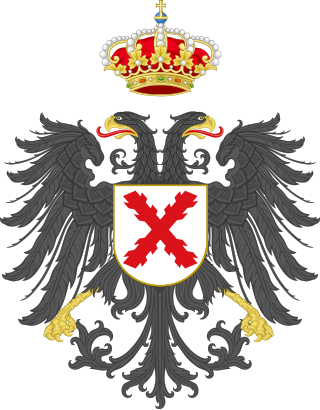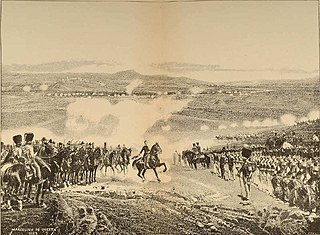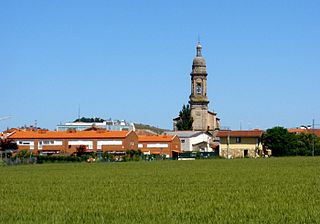
Tomás de Zumalacárregui e Imaz, known among his troops as "Uncle Tomás", was a Spanish Basque officer who led the Carlist faction as Captain general of the Army during the First Carlist War. He was occasionally nicknamed the "Wolf of the Amezcoas", making reference to his famous military victory in the region of Navarre.

Carlism is a Traditionalist and Legitimist political movement in Spain aimed at establishing an alternative branch of the Bourbon dynasty, one descended from Don Carlos, Count of Molina (1788–1855), on the Spanish throne.

The First Carlist War was a civil war in Spain from 1833 to 1840, the first of three Carlist Wars. It was fought between two factions over the succession to the throne and the nature of the Spanish monarchy: the conservative and devolutionist supporters of the late king's brother, Carlos de Borbón, became known as Carlists (carlistas), while the progressive and centralist supporters of the regent, Maria Christina, acting for Isabella II of Spain, were called Liberals (liberales), cristinos or isabelinos. Aside from being a war of succession about the question who the rightful successor to King Ferdinand VII of Spain was, the Carlists' goal was the return to a traditional monarchy, while the Liberals sought to defend the constitutional monarchy.

Luis Fernández de Córdova was a Spanish military general, diplomat and first Marquis of Mendigorria.

Marcelino de Oraá Lecumberri (1788–1851) was a Spanish military man and administrator. Born in Beriáin in Navarre, he distinguished himself as a cadet during the War of Spanish Independence. He was married to Josefa de Erice, later Condesa de Chiva y Vizcondesa de Oráa.

The Battle of Mendigorría Grand took place during the First Carlist War on July 16, 1835 south of Mendigorría, Navarre. The Carlists were commanded by Vicente González Moreno, who assumed this post after the death of Zumalacárregui at the Siege of Bilbao. The Carlist pretender Don Carlos was also at Mendigorría.

The Lord Eliot Convention, or simply the Eliot Convention or Eliot Treaty, was an April 1835 agreement brokered by Edward Eliot, 3rd Earl of St Germans between the two opposing sides of Spain's First Carlist War. It had as its aim not to end the war itself but to end the indiscriminate executions of prisoners of war by firing squad that had been committed by both sides.

The aduaneros were a special military force created by Tomás de Zumalacárregui during the First Carlist War. They were entrusted with the levying of revenue for various consumer goods. During the first years of the war, they prohibited the export and import of goods to isolated barracks and fortified villages that had sided with the Liberal (Isabeline) cause.

The Guías de Navarra were a Carlist battalion of the First Carlist War, created by Zumalacárregui in 1834.
The Battle of Alsasua, also known as the Battle of Altsasu or la Acción de la Venta de Alsasua, occurred on April 22, 1834 in Navarre, Spain, during the First Carlist War. Carlist general Tomás de Zumalacárregui attacked a convoy led by the Liberal general Vicente Genaro de Quesada traveling from Vitoria-Gasteiz to Pamplona at the town of Alsasua.
The First Battle of Arquijas was a battle of the First Carlist War.

The Battle of Alegría de Álava, a battle of the First Carlist War, occurred on October 27, 1834 at a field in Chinchetru, next to Alegría de Álava (Alegría-Dulantzi), Álava, Spain. It was a Carlist victory.

The Battle of Venta de Echavarri, a battle of the First Carlist War, occurred on October 28, 1834. It was an immediate follow-up to the Battle of Alegría de Álava, which had occurred the day before. It was a Carlist victory.
The Second Battle of Arquijas was a battle of the First Carlist War. It followed the First Battle of Arquijas. The battle was a second attack on the positions of Carlist commander Tomás de Zumalacárregui at the pass at Arquijas, Navarre.

Joaquín Llorens y Fernández de Córdoba was a Spanish Carlist soldier and politician. He is known as the longest serving Carlist deputy, the longest continuously serving Carlist deputy, and the most-elected Carlist deputy. He is also recognized for turning Requeté from a vague youth organization into a military force.

Manuel Polo y Peyrolón (1846–1918) was a Spanish writer, theorist, academic, and politician. He is best known as the author of five novels falling in between romanticism and realism; classified as part of costumbrismo, they are currently considered second-rate literature. As a philosopher he stuck to neo-Thomism and focused mostly on confronting Krausism. In education he represented Catholic regenerationism, fiercely pitted against the Liberal current. In politics he was active within Carlism; his career reached its peak during his 1896–1898 term in the Congress of Deputies and his 1907-1915 terms in the Senate.

Tomás Domínguez Arévalo, 6th Count of Rodezno, 12th Marquis of San Martin (1882–1952) was a Spanish Carlist and Francoist politician. He is known mostly as the first Francoist Minister of Justice (1938–1939). He is also recognised for his key role in negotiating Carlist access to the coup of July 1936 and in emergence of carlo-francoism, the branch of Carlism which actively engaged in the Francoist regime.

The Battle of Andoain was a military engagement of the First Carlist War that was fought on 14 September 1837. It took place around the Basque village of Andoain, south of the main Liberal stronghold of San Sebastián. Liberal troops under Leopoldo O'Donnell had captured Andoain on 9 September, driving the Carlist garrison there to the western bank of the Oria. Over the next three days, both sides constructed breastworks amidst intermittent skirmishes. After two days of trench warfare, Carlist troops poured heavy artillery fire on the Liberal lines and launched an all-out offensive, supported by reinforcements brought in from Navarre by José Ignacio de Uranga.

Duke of Victoria de las Amezcoas is a hereditary title in the Peerage of Spain, accompanied by the dignity of Grandee and granted posthumously in 1836 by carlist pretender to the throne Infante Carlos as Charles V to Tomás de Zumalacárregui, captain general of the Carlist army, along with the Countship of Zumalacárregui.

Queen Isabella II of Spain was barely three years of age when her father, King Ferdinand VII, died on 29 September 1833. The years of her minority were marked first by the regency of her mother, Maria Christina of the Two Sicilies, and then under General Baldomero Espartero, covering almost the first ten years of her reign, until 23 July 1843, when Isabella was declared to be of age.